Looking for How to Make Orange Marmalade! EASY, illustrated step-by-step instructions in 2024? Scroll down this page and follow the links. And if you bring home some fruit or vegetables and want to can, freeze, make jam, salsa or pickles, see this page for simple, reliable, illustrated canning, freezing or preserving directions. There are plenty of other related resources, click on the resources dropdown above. If you are having a hard time finding canning lids, I've used these, and they're a great price & ship in 2 days.
If you have questions or feedback, please let me know! There are affiliate links on this page. Read our disclosure policy to learn more.
How to Make Orange Marmalade! EASY, illustrated step-by-step instructions
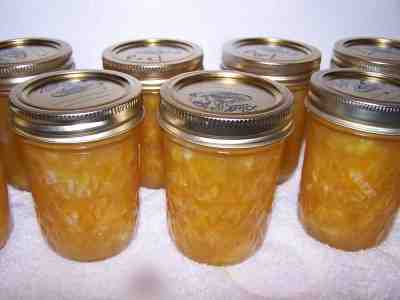 How
to Make Orange Marmalade! EASY, illustrated step-by-step instructions
How
to Make Orange Marmalade! EASY, illustrated step-by-step instructions
Click here for a PDF print version
Making and canning your own orange marmalade is also quite easy. Here's how to do it, in easy steps and completely illustrated. If your looking for a jam recipe and directions, click here! We also have directions to make applesauce, apple butter, pickles and others!
Ingredients
- Fruit - 8 whole oranges, thinly sliced (4 cups cut)
3 whole lemons, thinly sliced (1 1/2 cups cut) - Orange juice or Water - 4 cups of either. I use orange juice instead of water, for extra flavor.
- Sugar - about 4 cups of dry, granulated (table) sugar
- Pectin - 2 packages (boxes usually) or if you get it in bulk, 12 Tablespoons, see the directions below for specifics - (it's a natural product, made from apples and available at grocery stores (season - spring through late summer) and local "big box" stores. It usually goes for about $2.00 to $2.50 per box. See here for more information about how to choose the type of pectin to use.
Equipment
- Jar grabber (to pick up the hot jars) - Big box stores and
grocery stores sometimes carry them; and it is available online - see
this page. It's a tremendously useful to put jars in the canner and take
the hot jars out (without scalding yourself!). The kit sold below has
everything you need, and at a pretty good price:
- Jar funnel ($5 at Target, other big box stores, and often grocery stores; and available online - see this page) or order it as part of the kit with the Jar grabber .
- At least 1 large pot; I prefer 16 to 20 quart Nonstick ceramic coated pots for easy cleanup.
- Large spoons and ladles,
- 1 Water Bath Canner (a huge pot to sanitize the jars after filling (about $30 to $35 at mall kitchen stores, sometimes at big box stores and grocery stores.). Note: we sell canners and supplies here, too - at excellent prices - and it helps support this web site!
- Half pint canning jars (Grocery stores, like Publix, Kroger, Safeway carry them, as do some big box stores - now about $12 per dozen quart jars (up 50% in 2 years!) including the lids and rings)
- Lids - thin, flat, round metal lids with a gum binder that seals them against the top of the jar. They may only be used once.
- Rings - metal bands that secure the lids to the jars. They may be reused many times.
Optional stuff:
- Lid lifter (has a magnet to pick the lids out of the almost-boiling water where you sanitize them. ($4 at big box stores or it comes in the kit at left)
Orange Marmalade Directions
This example shows you how to make orange marmalade. The yield from this recipe is about 18 eight-ounce jars (which is the same as 9 pints). I'll explain both the way to make traditional orange marmalade (which in my opinion has a bitter edge to it) and an orange marmalade without the bitterness.
Step 1 - Select the fruit
If you are lucky enough to live in Florida or southern California you can go pick your own Oranges in January and February! Otherwise, you will have to go to the grocery store for the oranges and lemons.
Pick fresh oranges and lemons that are not soft, moldy or discolored.
Step 2 - Wash the fruit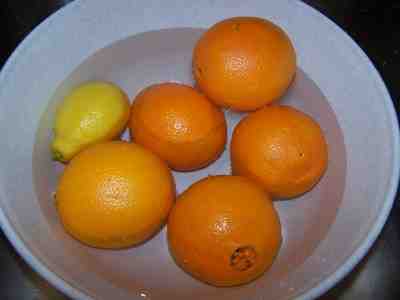
I'm sure you can figure out how to wash the fruit in plain cold water.
Step 3 - Get the jars and lids washed



Need lids, rings and replacement jars?
Get them all here, delivered direct to your home, at the best prices on the internet!
The dishwasher is fine for the jars; especially if it has a "sanitize" cycle; you don't really have to sanitize the jars - the boiling water bath sanitizes everything, jar, lid, contents and all; but you DO want to get the jars as clean as you can first. I get the dishwasher going while I'm preparing everything else, so the jars are clean and hot (and less likely to crack when you put boiling hot fruit in them) by the time I'm ready to fill the jars.
Lids: Put the lids into a pan of hot water for at least several minutes; to soften up the gummed surface and clean the lids.
Step 4 -Remove the outer part of the peel
Take a look at Step 10 - if you are going to use method 10a, then with a vegetable peeler, remove only the colored part of the peel and set it aside. This outer portion of the peel is what give marmalade its bitter taste. If you like it, chop it finely and set it aside for now.
If you don't like the bitterness, then you are going to use the method Step 10b, so just then just peel the fruit with your hands as shown in step 5 (and skip step 4)
Step 5 -Remove the remaining rind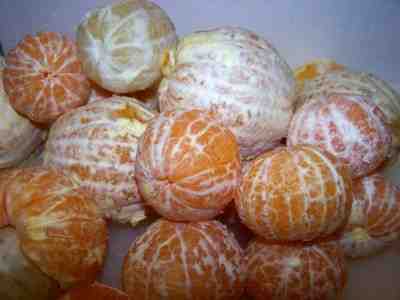
Using your fingers, peel off the remaining white portion of the rind, discard this - it is a tasteless and spongy
Step 6 -Slice the oranges and lemons in half

Cut the fruit in half, across the segments, as shown.
The tough, white part in the center must be cut out. But it does contain lots of natural pectin, so you can take a pair of scissors; just snip it out and cook it in cheesecloth with the fruit to extract the pectin..
Save any juice that leaks
out!
Step 7 - Chop the oranges and lemons
Next, slice the two halves into thin slices
And then chop the slices up a bit! Remove and discard any seeds or tough parts of the orange that you find in the process.
Continue to save any juice that leaks out!

Step 8 - Measure out the sugar
You will need to follow the directions that come with the pectin, but generally, the lower sugar pectin recipes call for about 4 cups of sugar per box, and the regular pectin calls for 7 cups of sugar.
Mix the dry pectin
with about 1/4 cup of sugar and Keep this separate fr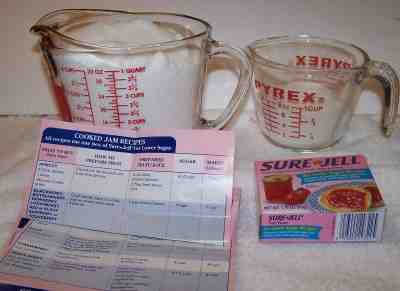 om
the rest of the sugar. If you are not using sugar, you will just have
to stir more vigorously to prevent the pectin from clumping.
om
the rest of the sugar. If you are not using sugar, you will just have
to stir more vigorously to prevent the pectin from clumping.
Note: you can also add some spice at this point, if you like!
Some people add 1 teaspoon of cinnamon, ginger or cloves.
Purists add none of these!
Step 9 - Mix the chopped oranges with the pectin
Stir the pectin into the chopped fruit. Put the mix in a big pot and
set aside for a moment.
Notes about pectin: For marmalade (which is difficult to get to set) I usually add about 50% - 100% more pectin (just open another pack and add a little) or else the jam is runnier than I like. With a little practice, you will find out exactly how much pectin to get the thickness you like.
Another tip: use the low sugar pectin. It cuts the amount of sugar you need from 7 cups per batch to 4 cups! And it tastes even better! On the other hand; I have never had success with the No-sugar pectin. It always turned out runny and bland. You might want to try using the low sugar recipe with a mixture of sugar and Stevia (in a prepared form like Truvia, it measures same as sugar; if you use another form, you will need do your own conversion) - or Splenda, if you prefer, ; that could work.

Is your jam too runny? Pectin enables you to turn out perfectly set
jam every time. Made from natural apples, there are als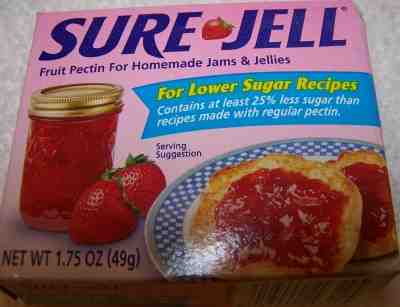 o
low-sugar pectins that allow you to reduce the sugar you add
by almost half!
o
low-sugar pectins that allow you to reduce the sugar you add
by almost half!
Get canning jars, rings, lids and pectin deliverd:
Step 10 -Cook the fruit - With Peels or Not?
Peels add the characteristic bitterness to marmalade, but some people do not like marmalade BECAUSE it is bitter - so here are both ways to make it (do one OR the other):
Step 10a - With the Peels:
If you want the characteristic bitter taste of marmalade, put the peels, use 2 cups of the original 4 cups of water or orange juice (for a richer flavor) and 1/8 teaspoon of baking soda in a saucepan.
Bring the mix to a boil. Cover it, turn down the heat and let it simmer for 20 minutes.
Add the chopped
fruit, the remaining 2 cups of juice and simmer for 10 minutes more.
Step 10b - Without the peels
If you want a less bitter taste, skip the preceding and instead place the chopped fruit and 4 cups of water or orange juice in a saucepan and simmer for 10 minutes
Step 11 - Add the sugar and
return to a boil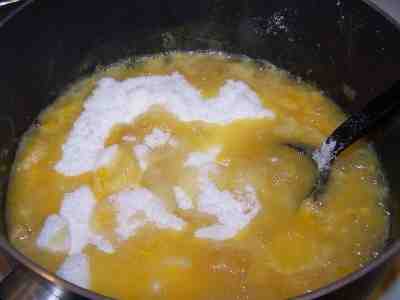
Add the sugar and bring the mixture back to a full boil.
Step 12 - Bring the mixture
to a full boil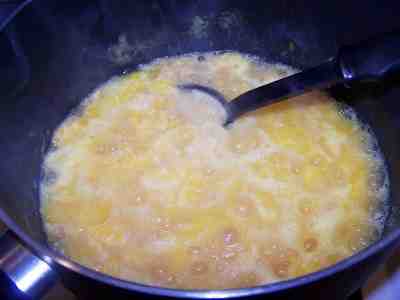
Stir the mix and bring it to a full boil, hard, for one minute.
Step 13 - Fill the jars and
put the lid and rings on
Fill them to within 1/4-inch of the top, wipe any spilled jam off the top, seat the lid and tighten the ring around them. Then put the filled jars into the canner!
This is where the jar tongs come in really handy!
Step 14 - Process the
jars in the boiling water bath
Keep the jars covered with at least 2 inches of water. Keep the water boiling. Boil them for at 15 minutes.
Note: Some people don't even boil the jars; they just ladle it hot into
hot jars, put the lids and rings on and invert them, but putting the jars in
the boiling water bath REALLY helps to reduce spoilage! To me, it makes
little sense to put all the working into making the jam and then not to
process the jars to be sure they don't spoil!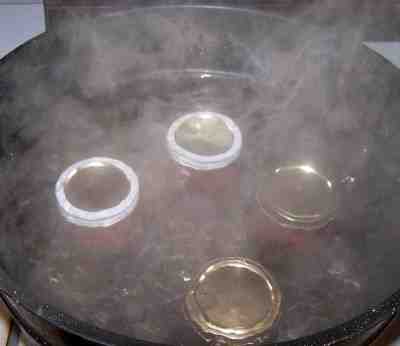
Step 15 - Done
Lift the jars out of the water and let them cool without touching or bumping them in a draft-free place (usually takes overnight) You can then remove the rings if you like, but if you leave them on, at least loosen them quite a bit, so they don't rust in place due to trapped moisture. Once the jars are cool, you can check that they are sealed verifying that the lid has been sucked down. Just press in the center, gently, with your finger. If it pops up and down (often making a popping sound), it is not sealed. If you put the jar in the refrigerator right away, you can still use it. Some people replace the lid and reprocess the jar, then that's a bit iffy. If you heat the contents back up, re-jar them (with a new lid) and the full time in the canner, it's usually ok.
It may take up to two weeks for the marmalade to set and thicken up. It will be runny until then!
Once cooled, they're ready to store. I find they last about 18 months. After that, the get darker in color and start to get runny. They still seem safe to eat, but the flavor is bland. So eat them in the first 12 to 18 months after you prepare them!
Summary - Cost of Making Homemade Marmalade - makes 10 jars of 8 oz each* |
||||
| Item | Quantity | Cost in 2024 | Source | Subtotal |
| Oranges | 8 medium or large sized | $2.00 | Grocery store | $2.00 |
| Lemons | 2 | $1.00 | Grocery Store | $1.00 |
| Canning jars (8 oz size), includes lids and rings | 10 jars | $11/dozen 8 oz jars or $0.92/jar |
Grocery stores (Publix, Kroger, Safeway, etc.) | $5.50 |
| Sugar | 4 cups | $2.00 | Grocery stores (Publix, Kroger, Safeway, etc.) | $2.00 |
| Pectin (low sugar, dry) | 1 and a third boxes | $2.00 per box | Grocery stores (Publix, Kroger, Safeway, etc.) | $2.70 |
| Total | $13.20 total or about $1.32 per jar |
|||
|
* - This assumes you already have the pots, pans, ladles,, and reusable equipment. Note that you can reuse the jars! Many products are sold in jars that will take the lids and rings for canning. For example, Classico Spaghetti sauce is in quart sized jars that work with Ball and Kerr lids and rings. Note that the Classico's manufacturer does not recommend reuse of their jars: see what they have to say on this page: |
||||
Can't find the equipment? We ship to all 50 states! Use our Feedback form!
Answers to Common Questions
- Why should cooked marmalade be made in small
batches?
If a larger quantity of juice is used, it will be necessary to boil it longer thus causing loss of flavor, darkening of the maramalade, and toughening of the finished product. It really doesn't work. Trust me; I've tried many times! - Should marmalade be boiled slowly or
rapidly?
It should be boiled rapidly, since long, slow boiling destroys the pectin in the fruit juice. - What do I do if there's mold on my
marmalade?
Discard jams and jellies with mold on them. The mold could be producing a mycotoxin (poisonous substance that can make you sick). USDA and microbiologists recommend against scooping out the mold and using the remaining jam or marmalade. - Why did my marmalade ferment, and what do I
do?
Jellied fruit products may ferment because of yeast growth. This can occur if the product is improperly processed and sealed, or if the sugar content is low. Fermented fruit products have a disagreeable taste. Discard them. - What happens if my jam or marmalade doesn't
gel?
Remaking cooked runny jam or marmalade instructions can be found on the U.Ga. website. Directions about remaking uncooked jams or jellies can be found in a CES Publication from Ohio State University.
If you want to learn how NOT to make marmalade, read this entertaining account from this Australian woman who is either incredibly cheap or a slow learner... but either way, it's a funny story!
And if our recipe is too EASY for you and you would like a much more complicated approach that will take about 4 hours to complete, try Delia Smith's (a cook who is famous in the UK) orange marmalade recipe!
Canning Books, Supplies and Accessories
These are my favorite essential canning tools, books and supplies. I've been using many of these for over 50 years of canning! The ones below on this page are just the sampling of. my preferred tools. but you can find much more detailed and extensive selections on the pages that are linked below.
- Vacuum Foodsealers for freezing, dried foods, and refrigerated foods - the FoodSaver line
- Selecting a KitchenAid mixer and attachments for home canning
- Steam Juicers
- Strainers, pit removers, seed-skin-stem removers, jelly strainers, etc. All types, makes and prices (from $19 to $350)
- Cherry pitters reviews, prices and ordering
- Food dehydrators - easy and fast to dry your own fruits, veggies, sun-dried tomatoes, etc.
The All New Ball Book Of Canning And Preserving: Over 350 of the Best Canned, Jammed, Pickled, and Preserved Recipes Paperback
This is THE book on canning! My grandmother used this book when I was a child.; It tells you in simple instructions how to can almost anything; complete with recipes for jam, jellies, pickles, sauces, canning vegetables, meats, etc.
If it can be canned, this book likely tells you how! Click on the link below for more information and / or to buy (no obligation to buy)The New Ball Blue Book of Canning and Preserving
Canning and Preserving for Dummies by Karen Ward
This is another popular canning book. Click here for more information, reviews, prices for Canning and Preserving For Dummies
Of course, you do not need to buy ANY canning book as I have about 500 canning, freezing, dehydrating and more recipes all online for free, just see Easy Home Canning Directions.
Home Canning Kits
See here for related tools, equipment, supplies on Amazon See here for related tools, equipment, supplies on Amazon
I have several canners, and my favorite is the stainless steel one at right. It is easy to clean and seems like it will last forever. Mine is 10 years old and looks like new.
The black ones are the same type of standard canner that my grandmother used to make everything from applesauce to jams and jellies to tomato and spaghetti sauce.
This complete kit includes everything you need and lasts for years: the canner, jar rack, Jar grabber tongs, lid lifting wand, a plastic funnel, labels, bubble freer, It's much cheaper than buying the items separately. It's only missing the bible of canning, the Ball Blue Book.
You will never need anything else except jars & lids (and the jars are reusable)!
The complete list of canners is on these pages:
- Water bath canners - Good for acidic foods, like applesauce, pickles, salsa, jams, jellies, most fruits
- Pressure canners - needed for low and non-acidic foods, like canned vegetables (corn, green beans, etc), and meats
- Canners for glass top stoves if you have a glass or ceramic stove
- Canners for induction stovetops
Pressure Canners
If you plan on canning non-acidic foods and low acid foods that are not pickled - this means: meats, seafood, soups, green beans corn, most vegetables, etc., then you ABSOLUTELY must use a Pressure Canner.
Of course, you can use a pressure canner as a water bath canner as well - just don't seal it up, so it does not pressurize. This means a Pressure Canner is a 2-in-1 device. With it, you can can almost ANYTHING.
There are also other supplies, accessories, tools and more canners, of different styles, makes and prices, click here!
Basic Canning Accessories
From left to right:
- Jar lifting tongs to pick up hot jars
- Lid sanitizer / lifter - to remove lids from the pot of boiling water (sterilizing )
- Lids- disposable - you may only use them once
- Ring - holds the lids on the jar until after the jars cool - then you remove them, save them and reuse them
- Canning Jar funnel - to fill the jars
FREE Illustrated Canning, Freezing, Jam Instructions and Recipes
Don't spend money on books. that you don't need to. Almost everything you can find in some book sold online or in a store is on my website here for free. Start with theEasy Home Canning Directions below. That is a master list of canning directions which are all based upon the Ball Bblue book, the National Center for Home Food Preservation and other reputable lab tested recipes. Almost every recipe I present in addition to being lab tested com. is in a step by step format with photos for each step and complete. explanations. that tell you how to do it, where to get the supplies and pretty much everything you need to know. In addition, there almost always in a PDF format so you can print them out and use them while you cook.
[ Easy Home Canning Directions]
[FAQs - Answers to common questions and problems]
[Recommended books about home canning, jam making, drying and preserving!]
Looking for canning equipment and supplies?
Water bath canner with a jar rack
Pressure canners for gas, electric and induction stoves: Presto 23Qt or T-fal 22Qt
Canning scoop (this one is PERFECT)
Ball Blue book (most recent version)
Jars: 8oz canning jars for jams
Find Other types of farms:
Farm markets and roadside stands
Road trips and camping resources
Local Honey, apiaries, beekeepers
Consumer fraud and scams information
Home canning supplies at the best prices on the internet!
Maple Syrup Farms, sugarworks, maple syrup festivals
Environmental information and resources
Farms For Your Event for birthday parties, weddings, receptions, business meetings, retreats, etc.
Festivals - local fruit and vegetable festivals
Get the
most recent version of
the Ball Blue Book
With this Presto 23 quart pressure canner and pressure cooker, you can "can" everything, fruits, vegetables, jams, jellies, salsa, applesauce, pickles, even meats, soups, stews. Model 01781

You can make jams, jellies, can fruit, applesauce, salsa and pickles with water bath canners, like this Granite Ware 12-Piece Canner Kit, Jar Rack, Blancher, Colander and 5 piece Canning Tool Set



